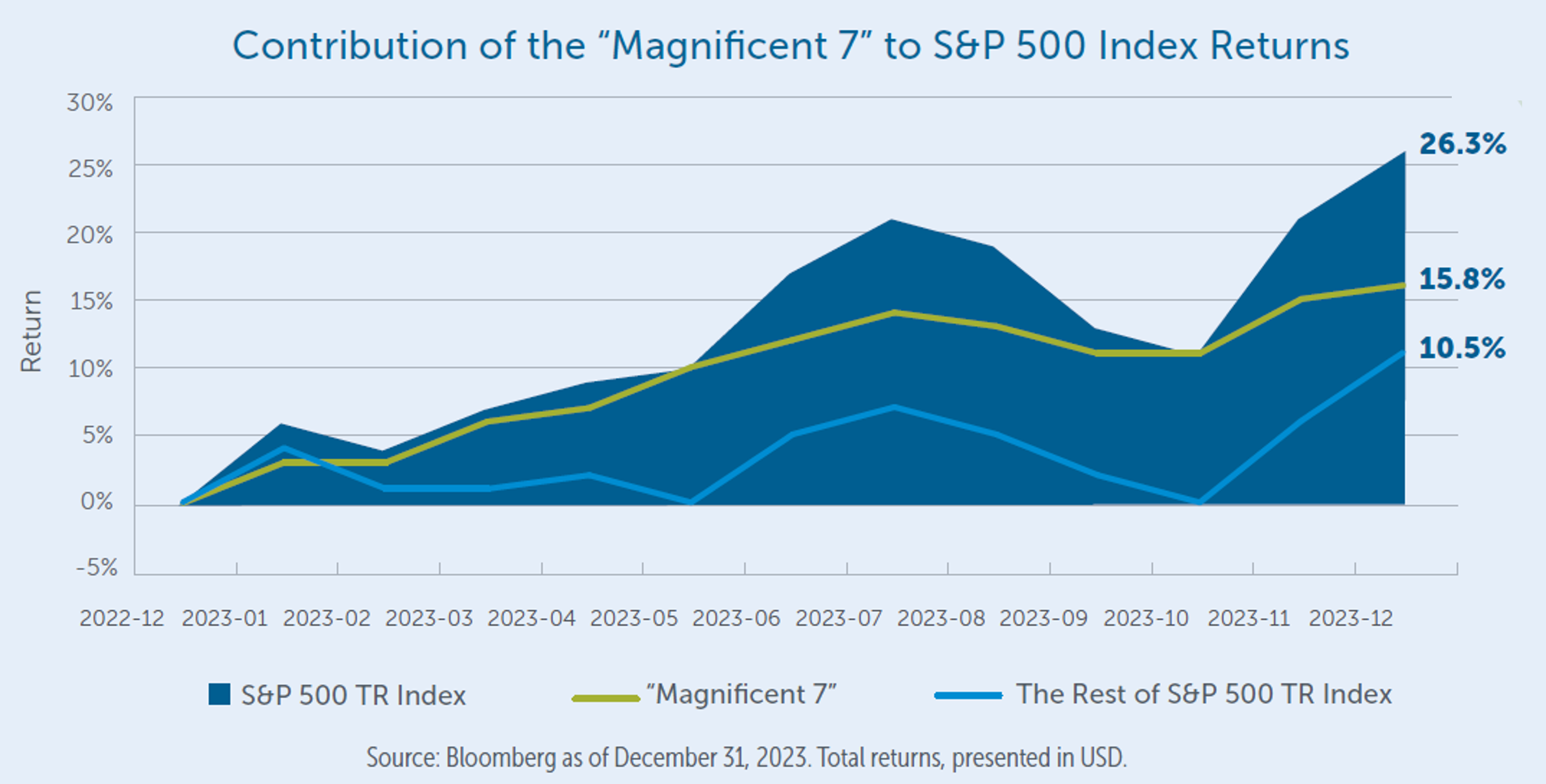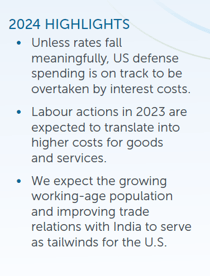2024 Market Outlook: U.S. equities

Last year was a volatile year in U.S. equity markets. In March, the failure of Silicon Valley Bank, a prominent lender in the tech industry with $210 billion in assets, was the first of a series of regional bank failures that later included Signature Bank, Credit Suisse and First Republic Bank. This led to fears of a broader banking crisis, although it was ultimately contained.
2023 overview
Outsized enthusiasm over the capabilities and future of generative AI also fueled a market rally. A group of several stocks dubbed the “Magnificent Seven,” comprised of Apple, Microsoft, NVIDIA, Amazon, Meta (Facebook), Tesla and Alphabet (Google), accounted for over 60% of the gains in the S&P 500 Total Return Index as of December 31, 2023. This performance can largely be attributed to their concentration level in the S&P 500 Index, which is constructed based on market capitalization.

Another top performer this year was gold, which benefited from the volatility caused by the regional banking crisis earlier this year and ongoing geopolitical events. Gold is largely seen as a “safe haven” asset and tends to perform well during periods of uncertainty.
Finally, despite a widely anticipated recession in 2023, the U.S. economy ended the year better than expected, with GDP growth of 2.1% expected for the year.1
2024 U.S. equities outlook
We’re entering the new year with a cautious view on U.S. equities.
With elections taking place this year, and early polls indicating it will be
a close race, we expect to see a budget deadlock in Congress to some
extent as partisan politics enters the equation.
The fiscal deficit nearly doubled to $1.84 trillion in 2023 from
$950 billion in 2022.2 With such a large debt load, defense spending
is on track to be overtaken by interest costs unless rates begin to fall.
Much like most of the other G7 economies, core inflation in the U.S. remains above the 2%  target. Although the Federal Reserve hinted at rate cuts during its last meeting in December, we expect that we will be in a “higher for longer” interest rate environment.
target. Although the Federal Reserve hinted at rate cuts during its last meeting in December, we expect that we will be in a “higher for longer” interest rate environment.
2023 was a tumultuous year across many different industries in the U.S. as workers participated in labour actions. These affected everyone from actors to nurses, hotel staff and pilots. The United Auto Workers union ratified new contracts with the “big three” manufacturers: Ford, General Motors (GM) and Stellantis. United Parcel Service (UPS) also reached a new labour agreement with the International Brotherhood of Teamsters, a union representing many UPS employees, in 2023. The agreements for the three automakers and UPS run through 2028 and we expect them to translate into higher costs for the respective companies as wage increases were a focal point of both contracts.
Some important secular trends that we will monitor in 2024 include innovation, energy, manufacturing, demographics and the re-emergence of India.
Secular trends we are monitoring
Innovation
 We’ll keep an eye on advancements in AI, and whether or not the space becomes more crowded as competitors such as Alphabet (Google) catch up to Open AI, the current market leader. Other innovations we’ll continue to monitor include gene sequencing technologies as they become less expensive, and equipment that will improve access to vast oil and gas reserves.
We’ll keep an eye on advancements in AI, and whether or not the space becomes more crowded as competitors such as Alphabet (Google) catch up to Open AI, the current market leader. Other innovations we’ll continue to monitor include gene sequencing technologies as they become less expensive, and equipment that will improve access to vast oil and gas reserves.
Energy
 We continue to monitor the transition to a green economy, focusing on key themes such as the establishment of renewable power generation (including wind and solar) and the role of nuclear energy, and improvements in electric vehicle infrastructure. As we transition to a greener economy, we will also be monitoring U.S. domestic oil and gas production. As the largest oil producer in the world, this has been a tailwind for growth and employment.
We continue to monitor the transition to a green economy, focusing on key themes such as the establishment of renewable power generation (including wind and solar) and the role of nuclear energy, and improvements in electric vehicle infrastructure. As we transition to a greener economy, we will also be monitoring U.S. domestic oil and gas production. As the largest oil producer in the world, this has been a tailwind for growth and employment.
Manufacturing
As relations between the U.S. and China have deteriorated, U.S.  companies have shifted their supply chains away from China in a bid to manage risks, starting the process of bringing it to friendlier shores or onshoring entirely. This is especially true for the creation of a domestic semiconductor supply chain.
companies have shifted their supply chains away from China in a bid to manage risks, starting the process of bringing it to friendlier shores or onshoring entirely. This is especially true for the creation of a domestic semiconductor supply chain.
Demographics
Unlike many other developed countries, the working-age population is expected to continue to grow in the U.S. for decades to come. This is expected to provide a tailwind to the U.S. economy.
Re-emergence of India
India has grown to become the fifth largest economy in the world. Yet, it is still in the relatively early stages of transitioning
away from an agrarian economy towards an industrial economy.
We expect that this will provide an economic tailwind for the U.S.
in terms of trade.
![]() Download the full Empire Life 2024 Market Outlook (PDF).
Download the full Empire Life 2024 Market Outlook (PDF).
1 IMF Data Mapper, October 2023 https://www.imf.org/en/Countries/USA
2 2024 Economic Outlook: 10 Considerations for the US Economy, JP Morgan Chase, https://www.jpmorgan.com/insights/outlook/economic-outlook/economictrends#:~:text=4.,from%20%24950%20billion%20in%202022
This document reflects the views of Empire Life as of the date published. The information in this document is for general information purposes only and is not to be construed as providing legal, tax, financial or professional advice. The Empire Life Insurance Company assumes no responsibility for any reliance on or misuse or omissions of the information contained in this document. Please seek professional advice before making any decisions.
Policies are issued by The Empire Life Insurance Company. A description of the key features of the individual variable insurance contract is contained in the Information Folder for the product being considered. Any amount that is allocated to a Segregated Fund is invested at the risk of the contract owner and may increase or decrease in value. Past performance is no guarantee of future performance.
Information contained in this report has been obtained from third party sources believed to be reliable, but accuracy cannot be guaranteed. Empire Life Investments Inc. is the Portfolio Manager of certain Empire Life segregated funds. Empire Life Investments Inc. is a wholly-owned subsidiary of The Empire Life Insurance Company.
February 2024






